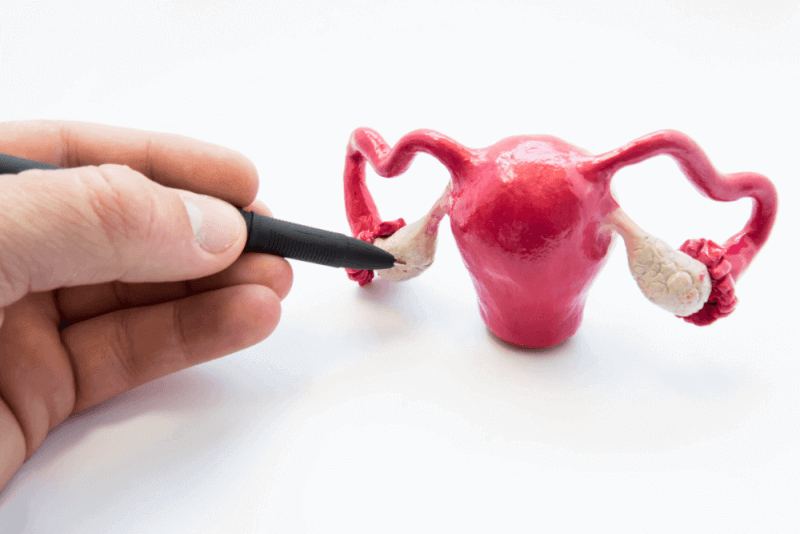30-Second Summary
- Women's menstrual cycles vary between 21 and 35 days. Cycles are calculated from the first day of menstruation. Bleeding outside of this period is referred to as menstrual irregularity.
- Women who have just started menstruating and those approaching menopause are excluded from this definition.
- If menstrual irregularity is suspected, a detailed history of the patient is reviewed. Subsequently, a gynecological examination is performed.
- Menstrual irregularity is not a disease but a symptom.
What is Menstrual Irregularity?
The female reproductive system thickens the uterine lining every 28 days to prepare for pregnancy. This thickened layer is rich in blood vessels. In cycles where pregnancy does not occur, this layer sheds to renew itself. During this shedding process, some bleeding occurs, known as menstruation or a period.
Women's menstrual cycles vary between 21 and 35 days. Cycles are calculated from the first day of menstruation. Bleeding outside of this period is referred to as menstrual irregularity.
What Causes Menstrual Irregularity?
There are various underlying reasons for menstrual irregularity. Bleeding between cycles is referred to as intermenstrual bleeding and usually results from a drop in hormone levels. The decrease in hormone levels causes the uterine lining to lose hormonal support, leading to spotting. Other factors that cause menstrual irregularity include the following:
- Endometrial Hyperplasia
- Lack of ovulation
- Issues related to ovulation
- Fibroids
- Polyps
- Cysts
- Hormone supplements taken externally
- Hormonal disorders
- Infections
- Malignant masses in the uterus and ovaries
What Are the Symptoms of Menstrual Irregularity?
The menstrual cycle considered normal varies between 21 and 35 days. Additionally, the duration of menstrual bleeding ranges from 2 to 7 days.
If women experience menstrual cycles outside of these time frames, it is considered menstrual irregularity. Apart from this, women who have just started menstruating and those approaching menopause are excluded from this definition. Other symptoms of menstrual irregularity include:
- Heavy bleeding
- Anemia
- Pain or cramps
- Vomiting
- Persistent fatigue
- Dizziness
What Are the Tests for Menstrual Irregularity?
If menstrual irregularity is suspected, a detailed history of the patient is reviewed. Subsequently, a gynecological examination is performed. During the examination, an ultrasound image is also taken to examine the uterus, ovaries, and surrounding structures.
After the examination, certain blood tests are requested to clarify the diagnosis. These include tests for estrogen, FSH, LH, and AMH. In some cases, tissue samples may also be taken.
To properly plan treatment, it is essential to understand the cause of menstrual irregularity. For this purpose, samples may need to be taken to determine if there is thickening or mass in the uterine lining.
What Are the Treatment Methods for Menstrual Irregularity?
Menstrual irregularity is not a disease but a symptom. Therefore, treating the underlying condition causing the irregularity is necessary for its resolution.
Hormone Therapy
If menstrual irregularity is caused by a hormone imbalance or deficiency, hormone medications are used to regulate hormone levels. Once hormone levels stabilize, the menstrual irregularity typically resolves.
Organic Causes
If an organic condition such as a polyp is causing menstrual irregularity, pathological tissues in the uterus are removed. Although fibroids typically do not cause symptoms, they may press on the uterine wall in some patients, leading to heavier bleeding. In such cases, the fibroids need to be removed.
Adolescent Menstrual Irregularity
There are various reasons for menstrual irregularity during adolescence. In cases where there is excessive bleeding, a clotting disorder is often observed, and treatment is applied accordingly.
Additionally, if menstruation occurs too early or too late during adolescence, it is important to identify and treat the underlying causes.
Menstrual Irregularity During Pregnancy
During pregnancy, ovulation does not occur, so women do not experience menstrual bleeding. Menstrual bleeding normally resumes after childbirth, but its onset is related to breastfeeding.
The bleeding that occurs immediately after childbirth is not considered menstrual bleeding; it is known as lochia. This bleeding, which lasts about six weeks, is more intense than regular menstrual bleeding, and its color changes over time.
Menstrual bleeding typically resumes between 8 and 16 weeks postpartum. However, because breastfeeding affects hormone levels, it may prevent bleeding from occurring.
Women who exclusively breastfeed are not expected to have a period within the first six months, and even if they do, it may not be regular. In some cases, mothers may not menstruate until their baby is 18 months old. In mothers who do not breastfeed, menstrual bleeding usually resumes between the 4th and 8th weeks postpartum.
Menstrual irregularity during this period can vary due to several reasons. If menstrual cycles occur less than 21 days apart or more than 35 days apart, it is considered menstrual irregularity, often related to breastfeeding.
Harms of Menstrual Irregularity
Menstrual irregularity can manifest in various ways, leading to a range of potential complications associated with irregular cycles.
Anemia
Anemia caused by heavy menstrual bleeding is a major reason for iron deficiency in women, especially those approaching menopause. Blood loss exceeding 80 ml per cycle can lead to anemia. Mild anemia is common among women experiencing heavy irregular bleeding, though severe anemia may also occur in certain cases.
Osteoporosis
In individuals with irregular menstruation, reduced estrogen levels can lead to a loss in bone density, increasing the risk of fractures. Irregular menstrual cycles, especially during growth periods, can significantly contribute to bone loss.
Infertility
Many conditions that cause menstrual irregularity can also lead to infertility. Consequently, women with irregular menstrual cycles may experience prolonged periods before conceiving, and in some cases, the possibility of conception may be eliminated.
Quality of Life
Menstrual irregularities, particularly those with painful and heavy bleeding, can severely impact productivity at work and school. They can also negatively affect social activities, reducing overall quality of life.
What Helps with Menstrual Irregularity?
It is recommended that individuals with menstrual irregularity first seek medical diagnosis and necessary treatment to determine the underlying cause. However, in some cases, home remedies may help alleviate symptoms. It is essential to consult a doctor before attempting any of these remedies. Some effective home remedies for menstrual irregularity include the following:
Yoga
Recent studies have increased research on various aspects of yoga, including its impact on menstrual irregularities. Studies indicate that women who practice yoga regularly experience more regular menstrual cycles, along with a significant reduction in cramps and body aches.
Ideal Body Weight
Weight gain or loss can affect the regularity of menstrual cycles. Significant weight loss is commonly associated with menstrual irregularities, while obesity can lead to more painful and heavier menstrual periods. Therefore, maintaining an ideal body weight is recommended.
Exercise
Regular exercise offers numerous benefits for individuals with menstrual irregularities. It helps maintain an ideal weight and is a crucial part of treating polycystic ovary syndrome (PCOS). Additionally, women who exercise regularly often experience a significant reduction in menstrual pain.
Ginger
Women with heavy menstrual bleeding have observed a considerable reduction in blood loss with regular ginger supplementation. Studies have also found that regular ginger consumption reduces pain intensity.
Studies indicate that consuming ginger during the seven days before menstruation can reduce premenstrual syndrome (PMS) symptoms.
Cinnamon
Cinnamon consumption can help alleviate symptoms caused by polycystic ovary syndrome (PCOS). It is also effective in reducing the severity of pain and bleeding.
Vitamins
Low levels of vitamin D are among the causes of menstrual irregularity. Vitamin deficiencies in general can affect menstrual cycles in multiple ways. Vitamin D is typically obtained through sufficient sun exposure, though individuals who lack sun exposure may need to take supplements.
Vitamin B deficiencies can lead to premenstrual syndrome (PMS). To prevent PMS, foods rich in vitamin B should be consumed, especially vitamin B6, which plays a significant role in alleviating PMS symptoms. A combination of vitamin B6 and calcium is recommended to help alleviate PMS.
Apple Cider Vinegar
Consuming 15 ml of apple cider vinegar daily can help alleviate symptoms of PCOS. For those who do not enjoy the taste, adding a tablespoon of honey is an acceptable alternative.
Pineapple
Pineapple is one of the most common home remedies for menstrual issues. The bromelain and other enzymes it contains help address various menstrual-related issues, particularly in reducing cramps associated with irregular periods.
Menstrual Irregularity and Birth Control Pills
While there are many different treatment options for menstrual irregularity, one of the first methods often considered is the use of birth control pills. Birth control pills not only help regulate menstrual cycles but also reduce cramps and bleeding.
Due to the hormones they contain, birth control pills are used to treat menstrual irregularities caused by conditions like PCOS, uterine fibroids, endometriosis, or other medical reasons.
Birth control pills used for treatment may contain both estrogen and progestin or only progestin. These medications can be prescribed in pill form or as other methods, such as intrauterine devices (IUDs).
Menstrual Irregularity After Unprotected Intercourse
The effects of sexual activity on menstruation have been studied for a long time. Research has shown that while hormone levels fluctuate throughout the month, sexual activity does not significantly affect these fluctuations. However, engaging in regular sexual activity has been linked to more predictable menstrual cycles because it affects ovulation and reduces stress, a known factor in irregular cycles.
If menstrual bleeding does not occur after unprotected intercourse, or if there is menstrual irregularity, pregnancy should be suspected, as unprotected intercourse is not directly related to menstrual irregularity.
Additionally, orgasm can help reduce menstrual cramps because dopamine, released in the brain, acts as a natural pain reliever. Endorphins also contribute to stress reduction.
Lastly, engaging in sexual activity close to the menstrual period can cause bleeding to start earlier. Sexual activity during the period can also lead to prolonged bleeding, especially after intercourse that causes uterine contractions.














E** S** | 21 Feb 2025